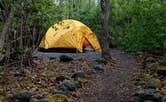Tent camping in Hope, Alaska occurs at elevations between 400-1,200 feet, creating temperature fluctuations of 15-20 degrees between day and night even in summer months. The region sits within the Chugach National Forest where alpine terrain transitions to coastal forest environments. Most campgrounds remain accessible from late May through September, with some backcountry areas requiring special considerations for changing weather conditions.
What to do
Glacier access hikes: Visit Exit Glacier Campground for direct access to glacier viewing trails. "There is a one mile wheelchair accessible trail loop with views of the glacier. There are two accessible camp sites," notes camper Samantha M. The main trail takes approximately 20 minutes from the parking area to reach glacier viewpoints.
Alpine exploration: For more adventurous hikers, the trails near Rabbit Lake Primitive Campsites connect to multiple backcountry routes. "This is a strange one. 4.4 mile hike up the road... I suggest parking at the rainbow trail head right down the way to the left that connects with multiple trails," advises Tanya B.
Ferry experiences: Take advantage of Alaska's unique marine transportation. "We took the Alaska Marine Highway from Whittier to Petersburg with stops in Yakutat and Juneau. Highly recommend getting a private room for overnight adventures but if you're on a budget you can bring your tent and camp gear up to the solarium," shares Sierra S.
What campers like
Natural sound environments: The running water near Coeur D'Alene Campground creates peaceful camping conditions. "Nice little campground with small amt of campsites, not really suitable for large groups or RVs so it's nice and quiet," reports Stacey C., adding that the campground's elevation makes it "chilly at night and early morning even in summer."
Site privacy: Tent campers appreciate the natural spacing between sites. "The further in you camp, the more privacy you score and the furthest away ends up by the gravel bar with the braided river lulling you to sleep," notes a camper at Exit Glacier Campground. Backcountry sites offer even greater seclusion.
Wildlife viewing opportunities: The surrounding area provides opportunities to observe Alaska's diverse fauna. "Lots of wildlife in the area (moose, porcupines, eagles, and more) and wildflowers! There's nothing like seeing a glacier at sunrise, worth the short hike from your tent," explains Amber A. when describing the best tent camping near Hope, Alaska.
What you should know
Bear safety requirements: All tent camping areas around Hope require strict food storage protocols. At Spencer Whistle Stop, you'll find "Clean restroom facilities, Bear proof food storage, Picnic tables, Fire ring," according to Tanya B. Rangers actively enforce these regulations, sometimes checking tents for food compliance.
Weather preparation: Alpine conditions demand appropriate gear regardless of season. "The campsite is at quite an elevation so is chilly at night and early morning even in the summer," confirms a camper. Temperature swings of 15-20°F between day and night occur regularly.
Insect conditions: Bug activity varies significantly by specific location and proximity to water. "The bugs are pretty heavy right next to the river but deep in the woods there are very few," reports a camper. Bringing insect protection is essential during summer months when temperatures rise.
Tips for camping with families
Accessibility options: Some areas offer accommodations for different mobility needs. "There is a one mile wheelchair accessible trail loop with views of the glacier. There are two accessible camp sites," notes a visitor to Exit Glacier Campground. These sites provide better access for families with young children or mobility concerns.
Day trip planning: Hope serves as a convenient base for exploring the broader Kenai Peninsula. "Close enough to Seward, but a ways down the road so a vehicle is recommended as the campground is a ways from town. Easy enough for a day trip into Seward tho for water activities, beach, brewery, etc.," suggests Adam S.
Cabin alternatives: For families seeking more shelter, Eagle River Nature Center provides "public use cabins/yurts" that are "accessible by foot year around. No horses or bikes allowed on trails. Tent camping along the Crow Creek Pass Trail."
Tips from RVers
Size restrictions: The best tent camping near Hope, Alaska generally doesn't accommodate larger recreational vehicles. At Crescent Creek, "Small campground only 9 sites, no host so pack in your wood. This poor campground needs some road work, lots of pot holes and short sites so large rigs won't fit here," warns Shadara W.
Bridge limitations: Access roads to some campgrounds have structural limitations. "You pass over three one lane bridges with a max of 10 tons allowed," notes a camper regarding Crescent Creek. These weight restrictions prevent larger RVs from reaching certain campgrounds.
Walk-in requirements: Most sites require walking gear from parking areas to actual campsites. "It's walk in, but not far from the car," explains a camper. This setup favors tent campers but creates challenges for those with extensive RV gear.



